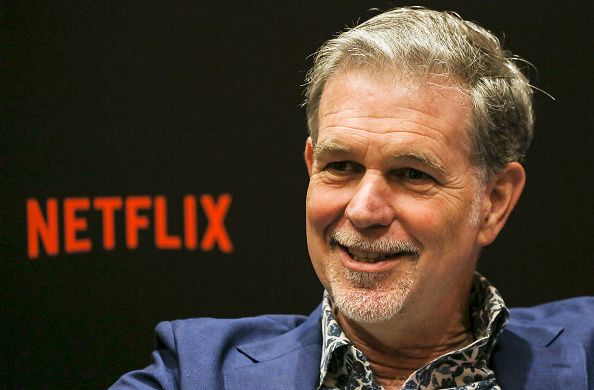BUSINESS NEWS
Why companies prepared for disruption are the smartest investment bets
[ad_1]
Netflix CEO Reed Hastings split the company in two in 2011, thinking that the growing ubiquity of high-speed Internet access would soon mean the end of their disruptive DVD mailing business. But neglecting the DVD business proved to be a mistake, and Netflix reversed course.
Ore Huiying | Getty Images
Some industries were safe from digital disruption, for a time. No longer. Companies in industries that were once seemingly immune to the forces of disruption — including health care, government services, manufacturing and finance — are now feeling the pressure to embrace business change just to survive.
In fact, an Accenture analysis of more than 3,600 companies with annual revenues of at least $100 million in 82 countries found that 63% of them face high levels of disruption, and 44% show severe signs of susceptibility to future disruption.
While this may sound alarming, the pace and timing of disruption is surprisingly predictable — and preventable — for both companies and their investors through a strategy we call the “wise pivot.”
From our ongoing study, we know that the successful companies continue to invest in today’s mature and core businesses even as they execute a carefully choreographed transition — a pivot — to new opportunities made possible by new technologies. They rebalance their assets, resources and innovation spending across their businesses in all three stages of the business life cycle — the old, the now and the new. This allows them to do something that makes investors rejoice: conquer disruption on disruption’s timeline.
To be sure, these companies are a rare breed. Only 2% of 1,000 companies we studied in another stream of research consistently grow both the portion of their share price that reflects expectations of future earnings growth, as well as the portion based on actual earnings.
The business leaders of these firms know not only where their company is positioned in this new disruption landscape but when disruption will take place. They see more clearly what’s changing around them, and they can predict and identify opportunities to create value from innovation for their business. They also know that large-scale transformations won’t work; they must instead keep pivoting.
At the opposite end, according to our research, companies struggling today tend to fall prey to the siren song of the ever-present and ever-promising new, moving too hastily to new horizons. They become so enamored of new businesses, new technologies and new markets that they neglect the old, and in doing so deprive themselves of the fuel for growth, which sits in those time-honored businesses. They’re all too quick to spurn the old and rush to the future, introducing innovative new products and services before their industry — and consumers — are ready. And then they have nothing to fall back on.
What makes a wise pivot
So what do these top-performing companies get right?
Rather than casting off their legacy businesses for pennies on the dollar, or treating them as “cash cows” to milk, they pour money back into them to prolong their profitability. This gives them a vital revenue stream to redirect toward future new businesses. They do this even to older products that many of their competitors have long since abandoned. Then, when the timing is right to move into new businesses, they pivot smoothly around those assets rather than lumbering away from them. This allows them to scale quickly into new markets from a more solid foundation — with the right combination of cost-effective technologies, business models and ecosystems.
Companies that pivot wisely embrace the new without rushing it. They know that their businesses need a war chest of robust earnings in today’s markets to fuel investments in future innovation.
Toyota is a good example of this. Instead of rushing its greener future, the Japanese car maker created a mass market for hybrid vehicles while maintaining growth in traditional internal combustion cars. As of 2017, Toyota had sold 4.3 million hybrid vehicles, the only company in the world to make a profit from the technology. Toyota’s competitors, meanwhile, are now playing catch-up.
Or take Netflix. Netflix’s leaders predicted in 2011 that the growing ubiquity of high-speed Internet access would soon mean the end of their disruptive DVD mailing business. So CEO Reed Hastings split the company in two, leaving the old business largely to fend for itself while the company’s best employees and most of the money went to building a first-of-its-kind streaming alternative.
But neglecting the DVD business proved to be a mistake, and Netflix reversed course.
Resuscitating the DVD service gave the company ample time to work out both technical and licensing bugs that were slowing the planned implementation of the streaming service. As it turns out, the DVD business is still going strong, with 3.4 million customers in 2017 and annual revenues of roughly $450 million. That not only fueled investment in the streaming business but helped Netflix with its next multibillion-dollar pivot to producing original content.
As these examples illustrate, companies that pivot wisely embrace the new without rushing it. They know that their businesses need a war chest of robust earnings in today’s markets to fuel investments in future innovation. Then, when the time comes, they have the agility to scale those new businesses to profitability.
But the wise pivot strategy, like all strategies, comes down to where resources are allocated and how resources are used. The rest, as they say, is just talk. Leading companies rely on and reinvent three core assets: their ability to innovate, their financial discipline, and the human capital of their employees and stakeholders. Together they comprise the essence of a company’s history, culture, and potential.
In the end, pivoting is inevitable. The question is how to do it wisely, with a portfolio of assets and investments balanced among the three business maturities. To get to the new, and get there every time, is the essence of the wise pivot. As investors know firsthand, getting it right takes patience, determination and resolve.
— By Omar Abbosh, Paul Nunes and Larry Downes, Accenture executives and co-authors of “Pivot to the Future: Discovering Value and Creating Growth in a Disrupted World”
[ad_2]
Source link













